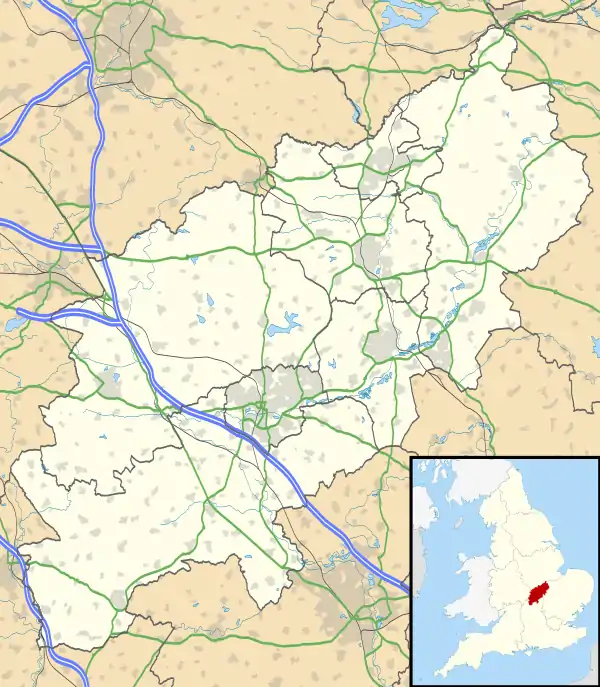Tiffield
Tiffield is a village and civil parish in Northamptonshire, England, north of Towcester between the A5 road to its west and the A43 road to its east.
| Tiffield | |
|---|---|
 Tiffield Location within Northamptonshire | |
| Population | 370 (2001 Census)[1][2] 362 (2011 census) |
| OS grid reference | SP698517 |
| • London | 67 miles (108 km) |
| Civil parish |
|
| District | |
| Shire county | |
| Region | |
| Country | England |
| Sovereign state | United Kingdom |
| Post town | TOWCESTER |
| Postcode district | NN12 |
| Dialling code | 01327 |
| Police | Northamptonshire |
| Fire | Northamptonshire |
| Ambulance | East Midlands |
| UK Parliament | |
Governance
Tiffield is part of the district of South Northamptonshire.
Demographics
The 2001 census[1] shows 370 residents, 185 each male and female, living in 142 dwellings. The population at the 2011 census included Adstone but had fallen to 362.[3]
Facilities
The primary school is one of the smallest in the country, with just 46 pupils in the 2007-08 academic year. It is Church of England, Voluntary Aided and has two classrooms. The old Victorian school building, used for KS2 and a 1960s mobile classroom for KS1, was to be demolished in summer 2008 and replaced by a modern classroom behind the Victorian building. Most pupils who leave the school progress to Sponne School in Towcester. There is a church dedicated to St John the Baptist which has a tower in the Decorated style and the body of the church was rebuilt in 1873 to designs by H. C. Vernon with a south aisle and porch by E. F. Law of 1859.[4]
Tiffield has a pub called The George. It also has a pocket park and a playing field, Claydon's Field, which was opened in 1979 after eight years of fundraising by villagers.
The village has one main road, which runs from the St John's turning on the A43 to the village of Gayton. Two 1960s roads exist: Pigeon Hill at the southern end of the village and Meadow Rise at the northern end. The village is approximately ½ mile long. It is linked directly to Gayton and Eastcote by road.
Tiffield Pocket Park was declared a Local Nature Reserve in 2008. The Pocket Park land was originally part of the Northampton and Banbury Junction Railway, which was closed in the 1960s. It now is a linear trail connecting several footpaths and rights of way. Three orchid species are found within the Pocket Park and may be seen flowering between April to June (depending on the season).
The Gateway School
The Gateway school teaches more than 50 pupils with behavioural, emotional and social difficulties. It moved from its old building in Raeburn Road, Northampton in May 2008 which cost £6.4m of government funding. The official opening ceremony was attended by the Duchess of Gloucester.[5] The site was occupied by an approved school many years ago and, before that the Northampton Society's Reformatory School for Boys which opened on 21 January 1856.[6]
Iron industry
There was an ironworks next to the railway to the south of the village. It lasted from 1875 to 1882. It operated the Siemens Direct Process using ore from a nearby quarry at Hulcote but the local ore was found to be unsuitable for that process. The quarry continued in operation, as did a newer quarry started closer to Tiffield in 1908, until 1920.[7]
See also
| Wikimedia Commons has media related to Tiffield. |
References
- "UK census 2001 - data". Retrieved 31 October 2008.
- SNC (2009). South Northamptonshire Council Year Book 2009-2010. Towcester NN12 7FA. p. 39.CS1 maint: location (link)
- "Civil Parish population 2011". Neighbourhood Statistics. Office for National Statistics. Retrieved 27 June 2016.
- Pevsner, Nikolaus; Cherry, Bridget (1973). Northamptonshire. Buildings of England (2nd ed.). London: Penguin. p. 431. ISBN 0-14-0710-22-1.
- "Chronicle & Echo, Northampton, 12 May 2008". Chronicle & Echo, Northampton. Retrieved 29 October 2008.
- "Reformatory School for Boys, Tiffield". Workhouse.org. Archived from the original on 5 June 2011. Retrieved 29 October 2008.
- Tonks, Eric (April 1989). The Ironstone Quarries of the Midlands Part 3: The Northampton Area. Cheltenham: Runpast Publishing. p. 62-67. ISBN 1-870-754-034.